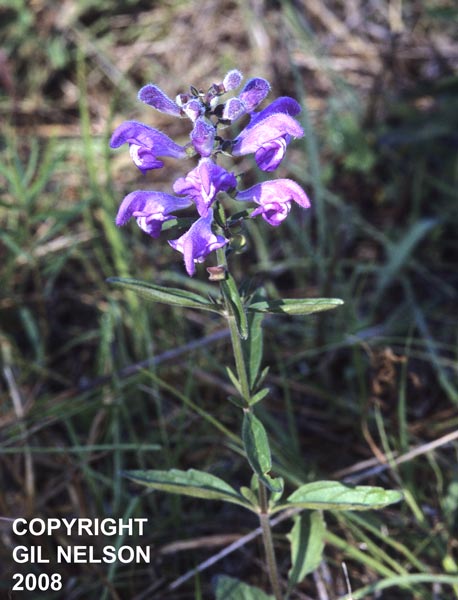Scutellaria integrifolia
| Scutellaria integrifolia | |
|---|---|

| |
| Photo taken by Gil Nelson | |
| Scientific classification | |
| Kingdom: | Plantae |
| Division: | Magnoliophyta – Flowering plants |
| Class: | Magnoliopsida – Dicotyledons |
| Order: | Lamiales |
| Family: | Lamiaceae ⁄ Labiatae |
| Genus: | Scutellaria |
| Species: | S. integrifolia |
| Binomial name | |
| Scutellaria integrifolia L. | |

| |
| Natural range of Scutellaria integrifolia from USDA NRCS Plants Database. | |
Common name: helmet flower
Contents
Taxonomic notes
Description
"Perennial herbs with quadrangular, erect to ascending stems; stolons absent, or present and underground. Leaves sessile or petiolate. Racemes bracteate, often paniculate. Calyx zygomorphic, 2-lobed, the upper lobe crested, very small in flower and enlarging in fruit; corolla zygomorphic , upper lip galeate, 3-lobed, lower lip unlobed, usually white in the throat. The blue-flowered species occasionally have white flowered forms. Stamens 4, exserted; stigma 2-parted. Mericarps dark brown to black, closely set with tubercles or papillae in somewhat concentric rings, rounded, often somewhat flattened." - Radford et al 1964
"Plant not stoloniferous, forming clumps of 1-several stems. Stems erect, 1.5-8 dm tall, simple or branched above, pubescent. Lowest leaves triangular-ovate, 0.7-3.5 cm long, 0.2-2 cm wide, obtuse or acute, crenate, base truncate to widely cuneate; petioles 0.8-2.5 cm long. Upper leaves lanceolate to narrowly elliptic, 2.5-6 cm long, acute or obtuse, entire to remotely crenate, base cuneate to attenuate; petioles 0-10 mm long, mostly obscured by blade tissue. Racemes 1-5 rarely more, terminating the stems, 0.3-2 dm long. Lowest bracts often leafy, reduced rapidly upward. Calyx 2.5-3 mm long in flower, 6-8 mm in fruit; corolla blue to violet, 1.3-2.5 cm long. Mericarps dark brown, tuberculate, the tubercles with broad apices, 1-1.5 mm long." - Radford et al 1964
Distribution
Ecology
Habitat
In the Coastal Plain in Florida and Georgia, S. integrifolia can be found next to flowing artesian wells, burned palmetto-slashpine flatwoods, burned longleaf pinewoods, pine savannas, longleaf pine sandhills, mixed woodlands, at the mouth of creeks in swampy woodlands, marshes, creek banks, oak-hickory woods, moist depressions in pine woodlands, Nyssa-Cypress swamps, floodplains, and edges of calcereous glades (FSU Herbarium). It can occur in disturbed sites such as roadside ditches, powerline corridors, hammock slopes, along railroad depressions, peaty ditches bordering flatwoods, swamp clearings, along gas pipe line corridors, and slight seepage swale in cutover upland longleaf pine savannas. Soils include sandy loam, loamy soil, loamy clay, and peaty soils (FSU Herbarium). Associated species include Rhexia petiolata, Polygala cruciata, Polygala, Drosera, and Lachnanthes (FSU Herbarium).
Phenology
It has been observed flowering March through July and fruiting March through July and November (FSU Herbarium).
Seed dispersal
According to Kay Kirkman, a plant ecologist, this species disperses by gravity. [1]
Seed bank and germination
Fire ecology
Pollination
Use by animals
Diseases and parasites
Conservation and Management
Cultivation and restoration
Photo Gallery
References and notes
Florida State University Robert K. Godfrey Herbarium database. URL: http://herbarium.bio.fsu.edu. Last accessed: July 2015. Collectors: Cecil R Slaughter, Loran C. Anderson, K. Craddock Burks, Robert K. Godfrey, Steve L. Orzell, Edwin L. Bridges, Grady W. Reinert, Andre F. Clewell, R. D. Houk, P. L. Redfearn, Jr., H. Kurz, Jean W. Wooten, E. S. Ford, P. White, Gary R. Knight, Sidney McDaniel, Elmer C. Prichard, Ira L. Wiggins, W. D. Reese, Herbert Monoson, Simpson, L. B. Trott, James D. Ray, Jr., George R. Cooley, Robert Kral, R. J. Eaton, H. Kurz, Ed Keppner, Lisa Keppner, R. A. Norris, R. Komarek, D. C. Hunt, Kevin Oakes. States and Counties: Florida: Alachua, Bay, Charlotte, Clay, Columbia, Escambia, Flagler, Franklin, Gadsden, Holmes, Jackson, Jefferson, Lake, Leon, Manatee, Nassau, Orange, Okaloosa, Osceola, Polk, Putnam, Santa Rosa, Seminole, Volusia, Wakulla, Walton. Georgia: Grady, Thomas. Compiled by Tall Timbers Research Station and Land Conservancy.
Radford, Albert E., Harry E. Ahles, and C. Ritchie Bell. Manual of the Vascular Flora of the Carolinas. 1964, 1968. The University of North Carolina Press. 902. Print.
- ↑ Kay Kirkman, unpublished data, 2015.